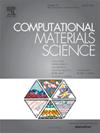半结晶聚合物加速参数识别的图神经网络驱动代理建模
IF 3.1
3区 材料科学
Q2 MATERIALS SCIENCE, MULTIDISCIPLINARY
引用次数: 0
摘要
在现象学模型中准确识别材料参数对于捕获半结晶聚合物的复杂行为至关重要。然而,有限元分析(FEA)中优化和概率算法的迭代性质往往使这一过程的计算量大和耗时,特别是当涉及高保真本构模型时。为了解决这些挑战,我们开发了一个基于图神经网络(gnn)的代理模型,以加速半结晶聚合物的参数识别过程。GNN代理模型在需要使用相同底层模型进行重复模拟的应用中表现出色,例如参数识别、设计优化和灵敏度分析,同时内在地实现全场预测和处理输入节点的灵活性,范围从稀疏实验测量到密集全场数据集。基于本构粘弹性、粘超弹性和粘塑性模型生成的数据对GNN进行训练。代理模型在广泛的参数范围内实现了高精度,尽管在训练集边界附近和外推期间注意到较大的误差。尽管存在这些限制,但通过近似计算密集型有限元模拟的输入输出关系,GNNs显着提高了速度和效率。GNN在速度方面优于有限元计算,与传统方法通常需要4个多小时相比,它在9秒内提供结果。计算效率的显著提高对于工业应用至关重要,例如数字制造,减少模型优化时间可以加速新材料和新技术的开发。本文章由计算机程序翻译,如有差异,请以英文原文为准。

Graph neural network-driven surrogate modeling for accelerated parameter identification in semicrystalline polymers
Accurately identifying material parameters in phenomenological models is crucial for capturing the complex behavior of semicrystalline polymers. However, the iterative nature of optimization and probabilistic algorithms within Finite Element Analysis (FEA) often makes this process computationally intensive and time-consuming, especially when high-fidelity constitutive models are involved. To address these challenges, we developed a surrogate model based on graph neural networks (GNNs) to accelerate the parameter identification process for semicrystalline polymers. GNN surrogate models excel in applications where repetitive simulations are required using the same underlying model, such as parameter identification, design optimization, and sensitivity analysis, while inherently enabling full-field predictions and flexibility in handling input nodes, ranging from sparse experimental measurements to dense full-field datasets. The GNN was trained on data generated from a constitutive viscoelastic, viscohyperelastic, and viscoplastic model implemented in FEA. The surrogate model achieved high accuracy across a wide range of parameters, although larger errors were noted near the boundaries of the training set and during extrapolation. Despite these limitations, by approximating the input–output relationships of computationally intensive FEA simulations, GNNs significantly enhance speed and efficiency. The GNN outperformed FEA computations in terms of speed, delivering results in under 9 s, compared to the 4 plus hours typically required by traditional methods. This significant improvement in computational efficiency is critical for industrial applications, such as digital manufacturing, where reducing model optimization time can accelerate the development of new materials and technologies.
求助全文
通过发布文献求助,成功后即可免费获取论文全文。
去求助
来源期刊

Computational Materials Science
工程技术-材料科学:综合
CiteScore
6.50
自引率
6.10%
发文量
665
审稿时长
26 days
期刊介绍:
The goal of Computational Materials Science is to report on results that provide new or unique insights into, or significantly expand our understanding of, the properties of materials or phenomena associated with their design, synthesis, processing, characterization, and utilization. To be relevant to the journal, the results should be applied or applicable to specific material systems that are discussed within the submission.
 求助内容:
求助内容: 应助结果提醒方式:
应助结果提醒方式:


